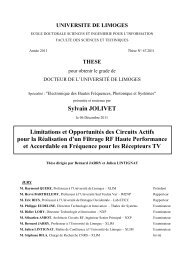Contribution à la conception optimale en terme de linéarité et ...
Contribution à la conception optimale en terme de linéarité et ...
Contribution à la conception optimale en terme de linéarité et ...
You also want an ePaper? Increase the reach of your titles
YUMPU automatically turns print PDFs into web optimized ePapers that Google loves.
FACTEUR DE FORME (dB)<br />
CHAPITRE II – CONSIDERATIONS GENERALES SUR LA LINEARITE DES AMPLIFICATEURS DE PUISSANCE<br />
1<br />
0,9<br />
0,8<br />
0,7<br />
0,6<br />
0,5<br />
0,4<br />
0,3<br />
0,2<br />
0,1<br />
0<br />
100 porteuses 1000 porteuses 10000 porteuses 100000 porteuses<br />
0 3 6 9 12<br />
Pdisp(dBm)<br />
Figure II.25 – Facteur <strong>de</strong> forme<br />
Afin d’évaluer le gain <strong>de</strong> précision apporté par c<strong>et</strong>te métho<strong>de</strong> nous avons représ<strong>en</strong>tés<br />
Figure II.26 l’évolution <strong>de</strong> <strong>la</strong> variance du NPR <strong>en</strong> fonction du niveau d’excitation <strong>et</strong> du<br />
nombre d’échantillons utilisés pour le calcul. Le nombre d’échantillon est donné <strong>en</strong><br />
pourc<strong>en</strong>tage <strong>de</strong> <strong>la</strong> ban<strong>de</strong> utile. La normalisation par rapport <strong>à</strong> <strong>la</strong> variance obt<strong>en</strong>ue <strong>en</strong> utilisant<br />
toute <strong>la</strong> ban<strong>de</strong> <strong>de</strong> bruit (100%) perm<strong>et</strong> une lecture directe du facteur temps gagné <strong>à</strong> l’ai<strong>de</strong> <strong>de</strong><br />
c<strong>et</strong>te métho<strong>de</strong>.<br />
Ce facteur n’est pas proportionnel au nombre d’échantillons <strong>de</strong> bruit utilisés comme<br />
nous aurions pu nous y att<strong>en</strong>dre sauf <strong>à</strong> forte puissance. En eff<strong>et</strong>, au-<strong>de</strong>l<strong>à</strong> d’une ban<strong>de</strong> <strong>de</strong> 20 %<br />
<strong>la</strong> variance n’évolue pratiquem<strong>en</strong>t plus.<br />
Le gain obt<strong>en</strong>u est <strong>en</strong> moy<strong>en</strong>ne <strong>de</strong> l’ordre <strong>de</strong> 10 par rapport <strong>à</strong> un signal <strong>à</strong> trou <strong>de</strong> 1% <strong>et</strong><br />
<strong>de</strong> 5 par rapport <strong>à</strong> un signal <strong>à</strong> trou <strong>de</strong> 5%.<br />
76<br />
15
















